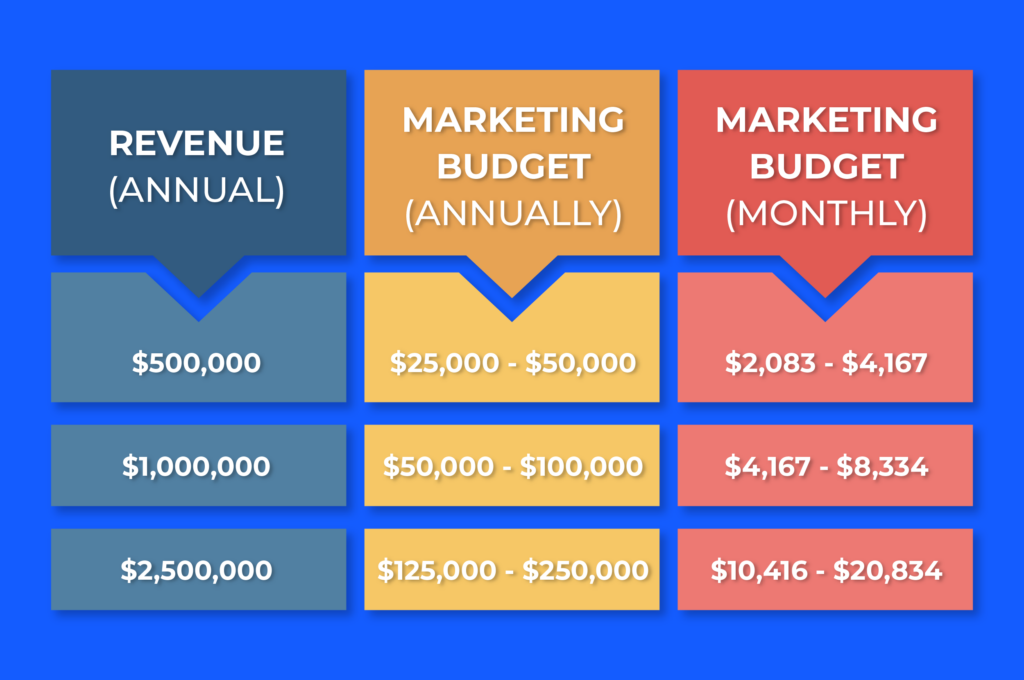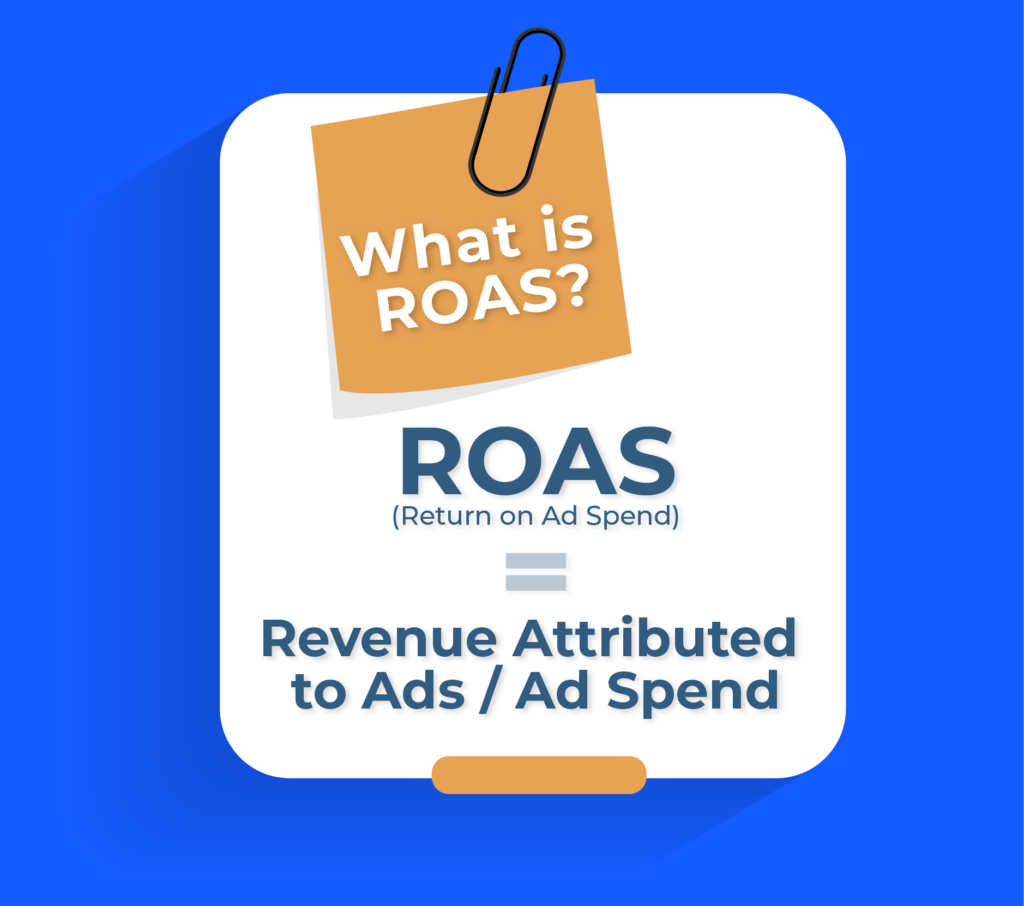A How-to Guide for Setting Your Starting Digital Advertising Budget
In a perfect world, this blog would be a short one. $50,000/month. Make it happen.
But we’re not in a perfect world, and your business likely isn’t ready to jump in with that big of an expense right out the gates. So, let’s be realistic.
Every prospective client who reaches out invariably asks the same question (though the phrasing may be different each time): what’s this gonna cost me?
In short? It depends. In long? Probably more than you’d like at first, but less than you’d be willing to spend after you see it work.
Let’s take a step back… What should you spend on marketing in general?
If you’ve done a recent Google Search, you’ll hear that your overall marketing spend should be between 5% – 10% of your company’s revenue.
That would look like the following, depending on your business:

The challenge with this figure is that it’s reactive – not proactive. In most cases, if you’re reaching out looking to grow your marketing spend, it’s because you have a desire to increase your revenue. Using last year’s sales numbers as a base may only produce you the same sales numbers again.
We believe in being good stewards of advertising spend, so when factoring in what you should spend on advertising – I’d focus less on a stagnant number, and more on a key metric: ROAS (or return on ad spend).
Alright, I’m hooked. What’s ROAS?
ROAS, or Return on Ad Spend, refers to the total revenue that you can attribute back to ads, divided by the advertising investment.
The equation is simple:

Looking at what you can afford to spend on advertising would be fruitless if you simply viewed advertising as a sunk cost. Digital advertising has a couple of key advantages that should be entered into this conversation:
- Your return on investment can be tracked
- Your advertising spend can readily increase or decrease
Measuring ROAS for eCommerce:
If you’re an eCommerce company, ROAS is simple to measure – and most advertising platforms (or any that are worth a darn) will do it for you.
For example, Meta Ads will look at the total amount you spent on ads, and the total amount of revenue generated from ads. If you spent $1,000 to make $10,000: congrats! Your ROAS is 10.
For practical purposes, you’ll also want to factor in whatever agency fee or employee labor went into the advertising side too, but let’s not overcomplicate things for now.
Measuring ROAS for Lead Gen:
If you’re a company that does offline sales, it gets a little bit more tricky to track. You can lean on offline tracking through certain CRMs and ad platforms, but the easiest way is this:
- Track your cost per lead (the average ad spend it takes to get a phone call or form fill)
- Know your close rate (the average percentage of leads that “close” and become a sale)
- Know your average order value (the average revenue from each customer).
Let’s say you’re a chiropractic office and your Google Ads net you a $30 cost per lead (you’ve spent $900 to get 30 leads). You also are able to close 50% of your leads (every other form fill or phone call becomes a customer). On average, each new customer brings $300 to your business.
That means that $900 got you 15 clients who signed at $300/piece. That’s revenue of $4,500 from $900 in ad spend, or a ROAS of 5.
Well, how far will my dollar go on digital advertising platforms?
Never as far as we’d like it to. But, it’s a good question to ask as that’s the other important part to factor into this equation.
If you start too small, you might not allow your ads enough of an opportunity to achieve your ROAS goals.
Some rough numbers that we’re seeing for top platforms can be found below:
- Google Search: $3 cost-per-click, $42 cost-per-thousand-impressions
- Google Display: $0.60 cost-per-click, $3 cost-per-thousand-impressions
- Facebook Ads: $1 cost-per-click, $8 cost-per-thousand-impressions
- LinkedIn Ads: $5 cost-per-click, $7 cost-per-thousand-impressions
- TikTok Ads: $1 cost-per-click, $5 cost-per-thousand-impressions
These are all generalized numbers and will vary greatly depending on your industry + your competition. In most cases, we recommend to clients that they start with a budget of $10 – 20/day per channel at a bare minimum. That would be ~$500 per month per medium on just ad spend.
Just get to the point: what should my starting budget be on digital ads?
Alright, I get it.
Short Answer Version:
Consider at least $2,000/month as a starting point.
Medium Answer Version:
It’s going to depend on the amount of channels you want to test & the competitive nature of your market. You’ll want to factor in the potential ROAS that you’d like to achieve, as well.So, if somebody asks you what your starting budget is, I’d answer just like this: “We’d like to start lean & be really strategic. Once we can have a proven ROAS, there’s room to scale. What are you able to do with a starting point of $2,000 – $3,000/month?”
Long Answer Version:
For a full answer that’s catered to you and your business, I’d recommend we chat about it. Shoot me an email at jack@adsharkmarketing.com. We don’t do hard sales & we say “no” to way more projects than we say “yes” to. I’ll give you an honest answer on where I think a good starting point would be, by leaning on some tools we have in-house to gauge competitiveness within your market and specific to your product line.
That wasn’t too long, was it?
I hope you enjoyed this blog! We love to help businesses build out a digital advertising plan that works for them. Please contact our team to learn more about our agency’s fees and which channels we would recommend for your business. In the meantime, continue to page through our blog for more helpful resources. See you again next week!
Ready To Grow?
Let's Talk!


